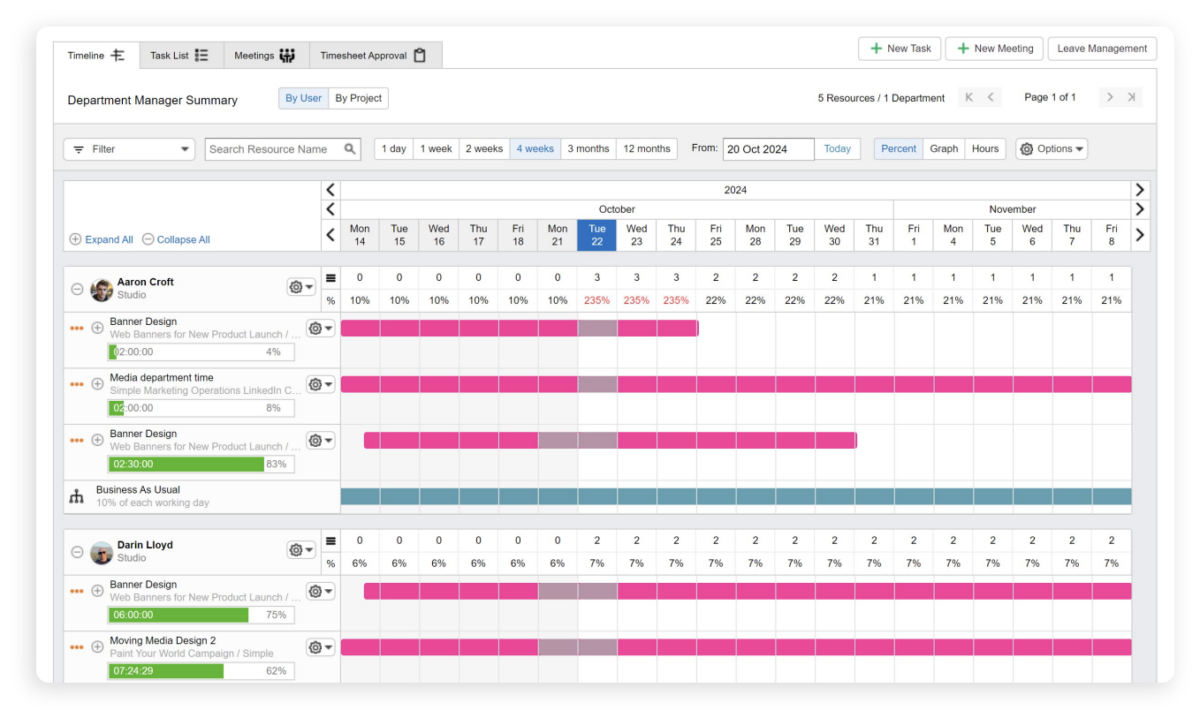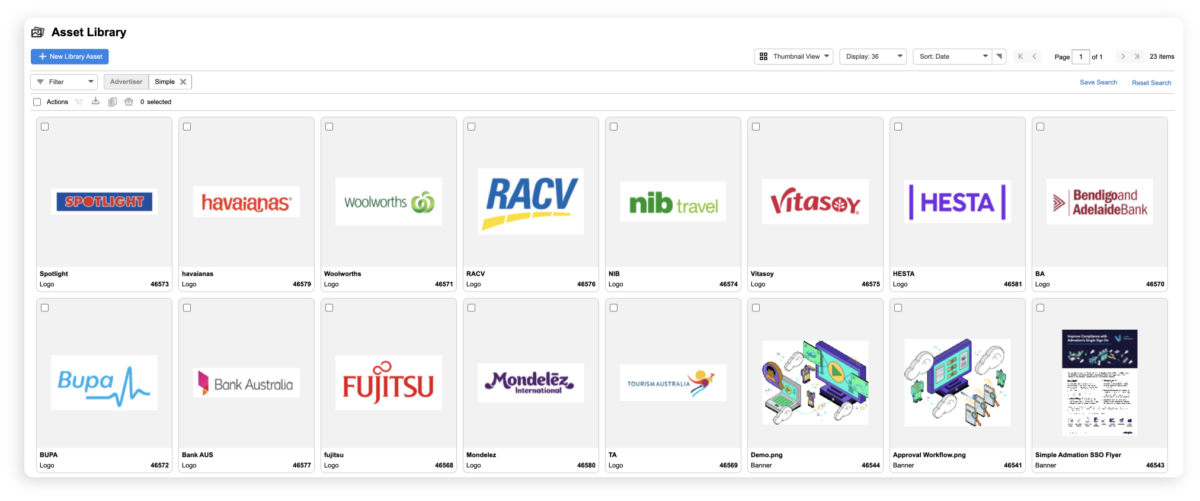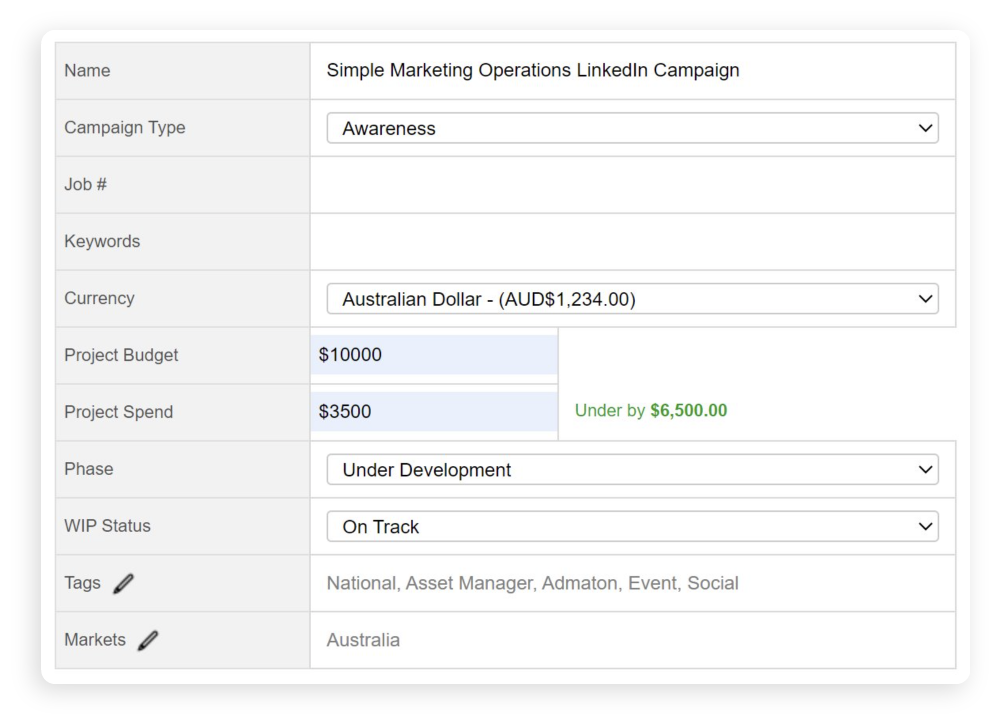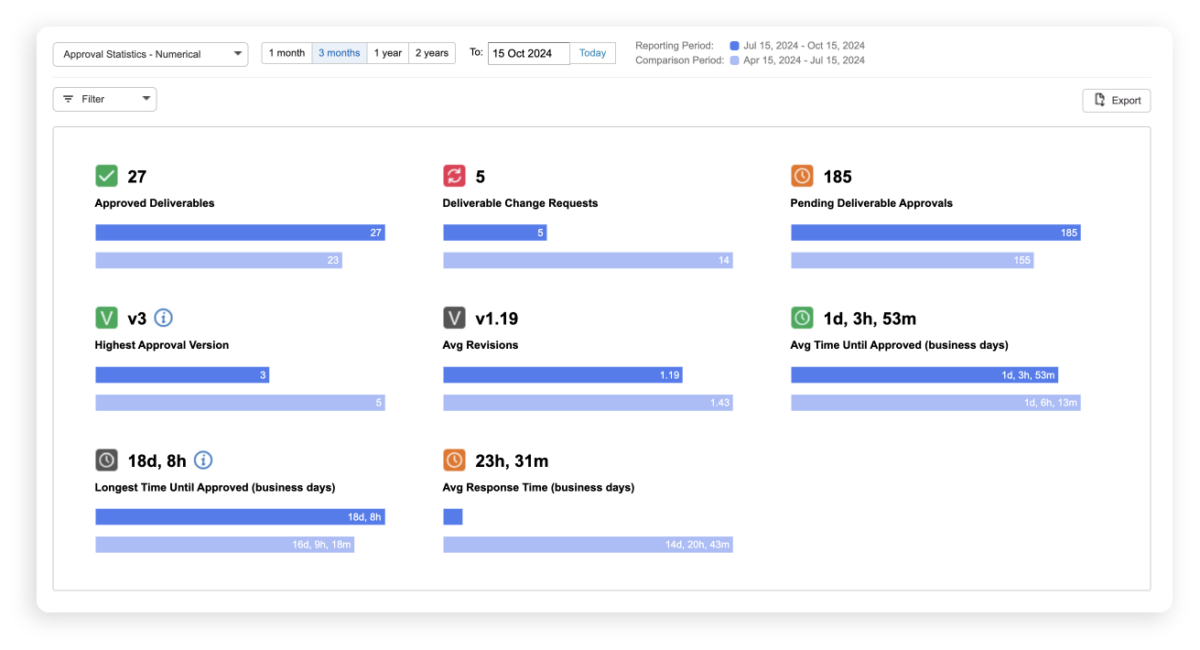Managing marketing resources with MRM software
Marketing teams today face an overwhelming number of tasks, campaigns, and resources to manage—often across multiple platforms and with varying deadlines. The need for efficiency, coordination, and visibility in marketing operations has never been greater. This is where Marketing Resource Management (MRM) software becomes essential.
MRM software allows marketing teams to centralise their planning, budgeting, asset management, and resource allocation, providing a more streamlined and effective way to execute marketing projects. It helps ensure that all resources—whether creative assets, budgets, or human resources—are optimised to achieve marketing goals while maintaining compliance and consistency.
In this guide, we will explore what MRM software is, the benefits it offers, and the challenges teams face without it. We’ll also dive into the essential features and highlight the best software solutions to consider. By the end, you’ll understand how it fits into the broader marketing operations strategy and how it can help your team work smarter, not harder.
What is Marketing Resource Management?
Marketing Resource Management refers to the strategies, processes, and technologies that help businesses manage their marketing resources more efficiently. This includes the careful planning, execution, and monitoring of marketing projects, ensuring that resources like people, budgets, content, and brand assets are effectively utilised. With the right platform, companies can streamline their marketing operations, enhance productivity, and maintain consistency across all marketing efforts.
MRM systems provide businesses with a centralised platform to manage marketing resources such as digital assets, tasks, creative teams, and approval processes. This ensures that internal and external stakeholders have clear visibility into marketing and brand strategy and operations and can collaborate more effectively.
Key Components of MRM
1. Resource Planning and Allocation
Effective management starts with the ability to plan and allocate resources, including personnel, budgets, and assets, based on the specific needs of brand campaigns. An MRM software solution enable the entire marketing team to schedule projects, assign tasks, and track resource availability in real-time. By ensuring the right resources are available at the right time, marketing teams can improve efficiency and minimise bottlenecks.

2. Digital Asset Management (DAM)
One of the core functions of MRM software is to manage digital assets, such as images, videos, and brand guidelines. A centralised repository of brand assets ensures that teams have quick access to the latest approved content, maintaining brand consistency and preventing the use of outdated materials. When it is integrated with Digital Asset Management (DAM) also streamline the process of searching, organising, and distributing marketing assets across various campaigns and channels.

3. Task Management and Workflow Automation
Task management is a critical component of a platform. By automating and managing task assignments and approval workflows, the management of complex marketing campaigns operations is simplified. Tasks are assigned to specific team members based on their roles, skills, and availability, and progress can be tracked in real-time. Automated workflows ensure that marketing teams follow a structured approval process, reducing the risk of delays, missed deadlines, and non-compliance. This feature enhances the overall efficiency of marketing operations by keeping projects on track and ensuring accountability.

4. Budgeting and Financial Management
Another essential feature of a solution is the ability to manage budgets and track expenditures of marketing projects. With the best solution, marketing teams can allocate budgets to specific campaigns, monitor spending, and ensure they remain within budgetary limits. This level of visibility helps businesses avoid overspending and make more informed financial decisions about their marketing activities.

5. Project and Campaign Management
MRM systems provide comprehensive project and campaign management capabilities, enabling marketing teams to plan, execute, and track the progress of various initiatives. From setting project timelines to managing dependencies and milestones, an MRM platform helps marketing departments maintain visibility into all aspects of their marketing efforts. This feature ensures that projects are completed on time and that any issues are identified and resolved promptly.

6. Reporting and Analytics
The ability to generate detailed reports is critical for evaluating the success of marketing campaigns. MRM software provides real-time insights into resource utilisation, budget allocation, and marketing performance. These analytics help businesses identify trends, optimise resource allocation, and measure the ROI of their marketing efforts. With robust reporting tools, marketing teams can make data-driven decisions to improve future marketing campaign.

The Benefits of Using Marketing Resource Management (MRM) Software
Investing in MRM software offers numerous advantages for marketing and creative teams. From better planning and budgeting to increased efficiency and resource optimisation, here’s why adopting an MRM system is essential for any marketing department aiming to improve their marketing operations:
1. Improved Planning and Budgeting
MRM software enables marketing teams to create detailed marketing plans with precise forecasts and budget estimates. This enhanced control over marketing resources allows for better tracking of campaign spending and real-time budget adjustments when necessary. By centralising all budget and resource data, businesses can stay within budget and make more strategic decisions about where to allocate resources, ensuring maximum return on investment (ROI).
2. Enhanced Team Collaboration
In many organisations, teams are dispersed across different locations, departments, or time zones. The marketing department can utilise resource management software to streamline operations, manage resources, and enhance communication. Marketing resource management software provides a centralised platform where team members, stakeholders, and external agencies can collaborate seamlessly. By eliminating communication silos, MRM platforms foster greater teamwork and ensure smooth execution of marketing campaigns. This kind of integration makes marketing management software a must-have for effective collaboration.
3. Resource Optimisation
Effective resource allocation is critical to successful marketing efforts. Training teams to manage resources effectively within the MRM system is essential, including practical examples of integration into daily marketing activities. MRM systems provide full visibility into the availability, workload, and skill sets of team members. This allows marketing managers to assign tasks efficiently, ensuring that no one is overloaded while under-utilised staff are given more responsibilities. By managing marketing resources with precision, businesses can boost productivity and keep projects on schedule.
4. Increased Efficiency and Automation
Manual processes, such as using spreadsheets or emails to track tasks, can lead to delays and inefficiencies. MRM platforms automate routine tasks like project timelines, task management, reminders, and approval workflows. This eliminates human error, speeds up the marketing execution process, and ensures timely approvals. Automation allows marketing teams to focus on strategic and creative work rather than administrative tasks, significantly improving overall efficiency.
5. Better Performance Tracking and Reporting
One of the key advantages of marketing resource management software is the ability to track the performance of campaigns and marketing activities in real-time. Whether it’s monitoring campaign progress, analysing budget usage, or measuring resource allocation, MRM systems provide critical insights. Comprehensive reporting tools allow teams to quickly identify successful campaigns and those that need adjustment. In addition, these reports help compliance and legal teams demonstrate the impact of marketing spend to senior leadership, further justifying the organisation’s investment in marketing efforts.
6. Consistent Brand Messaging and Asset Management
An essential feature of MRM software is the ability to manage digital assets, such as logos, videos, and images, through a centralised library. This ensures that all marketing materials are up-to-date, compliant, and consistent across campaigns. By preventing the use of outdated or unapproved assets, MRM platforms protect brand integrity and ensure compliance with brand guidelines and regulatory standards. In addition, integrated compliance features within the software provide a structured approach to maintaining consistency and adherence to marketing regulations.
The Challenges of Using Spreadsheets for Marketing Resource Management (MRM)
Despite the availability of advanced Marketing Resource Management (MRM) software, many creative teams still rely on spreadsheets to manage their resources, tasks, and budgets. While spreadsheets may seem familiar and accessible, they present numerous challenges that hinder efficient marketing resource management. Below are the common issues faced when using spreadsheets to manage resources.
1. Lack of Real-Time Collaboration
Spreadsheets are static documents that require manual updates, making it difficult for teams to collaborate in real-time. This becomes especially problematic when working across different time zones or in remote environments. Without real-time updates, marketing departments can face confusion, duplicated efforts, or delays. Unlike MRM software, which offers centralised platforms for collaboration, spreadsheets lack the tools needed to streamline teamwork and ensure everyone is working with the most up-to-date information.
2. Prone to Human Error
Manual data entry is a hallmark of spreadsheet use, significantly increasing the risk of human error. A single misplaced figure, incorrect formula, or incomplete data can lead to major inaccuracies in budget tracking, task management, and resource allocation. Errors can go unnoticed for days or weeks, often causing unnecessary delays, overspending, or under-utilised resources. In contrast, MRM systems automate many data processes, reducing the risk of error and ensuring data accuracy across your marketing project.
3. No Visibility into Resource Availability
Spreadsheets lack real-time insights into the availability and workload of team members. Without this visibility, project managers cannot efficiently assign tasks, often leading to team members being overbooked or under-utilised. This inefficient use of resources slows down project progress and can result in missed deadlines. In contrast, a central platform offers real-time views into how resources are allocated across projects, allowing for optimised resource management.
4. Time-Consuming Updates
Keeping a spreadsheet up to date with changing project statuses, budgets, and task assignments is time-consuming. Team members must manually input every change, taking time away from high-priority tasks. Version control is also a significant issue—multiple versions of the same spreadsheet can lead to confusion and errors. By comparison, MRM platforms automate updates and allow all team members to work from the same system in real-time, streamlining the workflow.
5. Limited Reporting and Analytics
Spreadsheets offer very limited reporting and analytics capabilities, which is a major disadvantage when tracking the performance of marketing projects and resource usage. Generating detailed reports often requires complex formulas and manual effort, making it difficult for teams to gain insights into marketing return on investment (ROI), budget performance, or resource utilisation. MRM software solution provides built-in analytics and reporting features, offering real-time insights that help businesses optimise their campaign planning and marketing programs.
6. Difficulty in Managing Approvals
Approval processes are crucial for marketing content, especially when compliance with legal and brand guidelines is involved. Spreadsheets do not support integrated approval workflows, making it difficult to track who has reviewed or approved particular assets. This can result in missed approvals, delays, or even non-compliant marketing materials reaching the market. In contrast, MRM systems offer automated approval management features, streamlining the process and ensuring compliance at every step of the project.
Key Features of Effective Marketing Resource Management Software (MRM)
To overcome the challenges of spreadsheets, organisations need to invest in Marketing Resource Management (MRM) software. Below are the essential features that every MRM solution should include to streamline marketing operations, enhance task management, and optimise resource allocation.
1. Centralised Resource and Project Planning
An effective MRM platform allows in-house teams to centralise all project planning and resource management into a single system. This includes a marketing calendar for manage project timelines, assigning tasks, and defining campaign objectives, all while offering visibility into who is working on which tasks and when. Centralising these processes helps marketing departments manage marketing resources effectively, ensuring alignment on deadlines, upcoming milestones, and reducing the risk of miscommunication.
Admation’s resource planning tool provides a visual dashboard that shows a complete overview of your team’s workload, including detailed charts that display each resource’s capacity. With this tool, marketing managers can quickly ascertain what tasks their team is working on and adjust allocations as needed.
2. Integrated Approval Workflows
Approval workflows are crucial, especially when marketing campaigns require legal, compliance, or brand review before going live. MRM software with built-in approval management automates this process, ensuring the correct stakeholders review and approve materials at the appropriate stages. This eliminates the inefficiencies of tracking approvals via email or spreadsheets, ensuring that nothing is published without proper sign-off.
Admation’s approval workflow feature includes customisable templates that streamline workflow management and the approval process, allowing for efficient review of all marketing collateral. This ensures that all campaign assets are compliant and consistent across all channels.
3. Task Management and Task Allocation
Task management is a key feature in any MRM system. The ability to assign tasks, set deadlines, and allocate resources effectively ensures that the right people are working on the right tasks at the right time. With task allocation tools, project managers can view real-time workloads and make adjustments to avoid bottlenecks or underutilisation. This optimises resource use and ensures projects stay on track.
Admation’s ‘Brief and Assign Task’ feature simplifies task allocation. Managers can easily view resource availability and assign tasks accordingly, minimising the risk of overbooking resources or missing deadlines.
4. Digital Asset Management (DAM)
An effective MRM solution should include a Digital Asset Management (DAM) feature to store, organise, and manage marketing assets such as logos, videos, images, and brand guidelines. Centralising these assets ensures that all team members across the marketing department have access to the most up-to-date versions, maintaining brand consistency across campaigns and preventing the use of outdated or unapproved materials.
Admation’s DAM system ensures all digital assets are stored in a centralised location, with the added benefit of tracking usage rights and ensuring compliance with licensing agreements.
5. Real-Time Collaboration
Collaboration is key to successful marketing projects. MRM platforms facilitate real-time collaboration, allowing team members, external agencies, and stakeholders to communicate and share feedback directly within the system. Whether reviewing creative concepts or discussing project updates, this functionality improves efficiency, minimises delays, and reduces the risk of miscommunication.
Admation’s collaborative tools ensure that all stakeholders can log into the system, review content, provide feedback, and approve assets online.
6. Performance Tracking and Reporting
One of the most valuable features of MRM software is its ability to track the performance of marketing campaigns and activities in real time. Teams can monitor campaign progress, track resource utilisation, and measure ROI. Detailed reporting allows marketing managers to generate insights, make data-driven decisions, and demonstrate the value of marketing initiatives to senior leadership.
Admation’s reporting tools enable users to generate custom reports that provide insights into campaign performance, resource allocation, and overall productivity. Managers can use these insights to better plan for future projects.
7. Customisable Templates and Checklists
Customisable templates and checklists help streamline repeatable marketing processes, ensuring that all tasks are completed accurately and efficiently. An effective MRM solution should offer templates for project briefs, task lists, and approval workflows to standardise processes. This reduces the risk of missing critical steps and ensures campaigns comply with legal, regulatory, and brand guidelines.
Admation’s resource templates allow marketing teams to save time by reusing task and project structures, reducing the need for many repetitive tasks and administration.
8. Automated Notifications and Reminders
Automated notifications and reminders ensure that tasks, approvals, and deadlines are not overlooked. These alerts keep team members informed of their responsibilities and help prevent project delays. By automating notifications, MRM platforms improve accountability and ensure that nothing falls through the cracks.
Admation’s automated notifications help keep projects on track by reminding team members of upcoming tasks, deadlines, and approvals.
9. Compliance and Audit Trails
Effective MRM solutions include integrated compliance features that help teams maintain audit trails of all project activities. These trails track feedback, changes, and approvals, providing a clear record of who did what and when. This is especially critical for organisations that must adhere to regulatory requirements, as maintaining audit trails helps mitigate compliance risks and ensures full transparency in the review and approval process.
Admation’s compliance feature provides an automatic audit trail for all marketing assets, making it easier to track the entire approval process and ensure compliance with legal and regulatory standards.
The Challenges of Relying on Spreadsheets
Despite the availability of advanced Marketing Resource Management (MRM) software, many organisations continue to rely on spreadsheets to manage their marketing teams. However, while spreadsheets may seem familiar and cost-effective, they come with significant challenges that limit efficiency and hinder the optimisation of marketing processes. Let’s explore the common issues faced by teams that still depend on spreadsheets to manage resources and tasks:
1. Lack of Real-Time Collaboration
Spreadsheets are static documents, often requiring manual updates. This makes real-time collaboration difficult, especially for teams working across different time zones or remotely. Multiple team members working on the same document can lead to version control issues, causing confusion and slowing down project progress. MRM software allows for dynamic, real-time collaboration, ensuring that every team member has access to the most up-to-date information, preventing bottlenecks.
2. Increased Risk of Human Error
Spreadsheets require manual data entry, and this reliance on humans increases the likelihood of mistakes. A simple error in a formula or the misplacement of data can skew entire projects, causing delays, cost overruns, or resource misallocation. MRM systems automate processes, reducing the potential for human error and ensuring data accuracy throughout project execution.
3. Limited Visibility into Resource Allocation
Spreadsheets do not provide an effective way to track resource availability or workload distribution. Without a real-time overview of resource allocation, it’s easy for team members to become overwhelmed or under-utilised, leading to inefficiencies. MRM platforms offer real-time visibility into team workloads, making it easier to assign tasks based on availability and prevent project bottlenecks.
4. Time-Consuming Updates
Managing marketing resources through spreadsheets can be a slow, laborious process. Each update, whether it’s to a budget, timeline, or resource allocation, requires manual input, which consumes valuable time. Additionally, any changes must be communicated across teams, further complicating the workflow. With MRM software, updates happen automatically, freeing up time for more strategic work.
5. Lack of Integrated Approval Workflows
One of the major drawbacks of using spreadsheets for marketing resource management is the absence of built-in approval workflows. Marketing teams often need approval from multiple stakeholders, including compliance and legal teams. Without a streamlined approval process, projects can experience delays, and assets might go live without proper oversight. MRM platforms include automated approval workflows, ensuring every piece of marketing material is reviewed and approved in a timely manner.
6. Insufficient Reporting and Analytics
Spreadsheets do not offer advanced reporting or analytics capabilities. Marketing teams need detailed insights into campaign performance, resource allocation, and ROI to make data-driven decisions. MRM systems provide comprehensive reporting features, allowing managers to generate custom reports and analyse resource utilisation, campaign outcomes, and other key metrics. This helps optimise future strategies and justify marketing investments.
7. Poor Compliance Management
Spreadsheets do not provide the necessary tools to manage regulatory compliance or maintain an audit trail for marketing projects. Tracking approvals, feedback, and revisions manually across documents can lead to confusion and increase compliance risks. MRM software with integrated compliance features ensures that all project activities are documented, and audit trails are maintained to meet regulatory requirements.
MRM as Part of a Comprehensive Marketing Operations Platform
For teams to fully optimise their resources, the selected solution should not be a standalone but integrated into a larger Marketing Operations Platform or Marketing Project Management Solution. This integration combines project briefing, task management, approval workflows, and resource optimisation, providing a holistic solution for managing marketing projects from start to finish.
1. Integration with Project and Task Management
Integrating MRM software with project management tools enhances overall operational efficiency. Internal teams can assign tasks, set deadlines, and monitor project progress while simultaneously managing resources and budgets. This integration ensures that resources are optimised, tasks are properly allocated, and projects stay on schedule.
2. Streamlined Approval Management
An MRM platform that includes integrated approval management features provides teams with the ability to automate approval workflows. This ensures that legal, compliance, and brand approvals are obtained in a timely manner, reducing delays and maintaining compliance with industry regulations. By integrating approval workflows into the broader marketing operations system, teams can ensure that projects move forward smoothly without sacrificing quality or compliance.
3. Enhanced Visibility Across Marketing Operations
A comprehensive MRM system offers marketing managers real-time visibility into all aspects of their marketing operations. This includes tracking the status of campaigns, monitoring resource availability, and ensuring that projects are aligned with organisational goals. By combining MRM with project management, teams can make informed decisions, allocate resources more effectively, and avoid resource bottlenecks.
4. Improved Collaboration Across Teams and Departments
When MRM software is part of an integrated marketing operations platform, collaboration becomes significantly easier. Teams across departments—whether it’s marketing, creative, legal, or compliance—can work together seamlessly, sharing feedback, tracking project milestones, and reviewing content in real time. This not only improves the speed of project execution but also enhances the quality of work being produced.
5. Comprehensive Reporting and Data-Driven Insights
Integrating MRM software with marketing operations tools allows for comprehensive reporting and analytics across all campaigns and projects. Teams can generate detailed reports that offer insights into performance, resource allocation, and ROI. With these data-driven insights, marketing managers can make informed decisions about future projects and demonstrate the effectiveness of marketing strategies to senior leadership.
6. Enhanced Compliance Management
A marketing operations platform with integrated MRM and compliance management features offers full compliance oversight across all marketing activities. By centralising the approval process, tracking feedback, and maintaining audit trails, creative teams can ensure that all campaigns meet regulatory requirements. This is especially important in industries like finance or healthcare, where strict compliance regulations must be followed.
Choosing the Right MRM Software for Your Business
Choosing the right MRM solution is critical for improving your team’s productivity, collaboration, and compliance management. Here are some key factors to consider when selecting an platform for your business:
1. Scalability and Flexibility
Your MRM software should be scalable to accommodate your organisation’s growth. As your team expands and your marketing needs become more complex, your software must be flexible enough to grow with you. Look for an MRM solution that allows you to customise templates, workflows, and reporting to suit your team’s unique requirements.
2. User-Friendly Interface
Adopting new software can be challenging, so it’s important to choose an MRM system that is easy to use and intuitive for your team. A simple, user-friendly interface will encourage faster adoption, allowing your team to take full advantage of the software’s capabilities without requiring extensive training.
3. Comprehensive Task and Resource Management
A robust MRM system should provide comprehensive tools for task management, resource allocation, and project tracking. It should allow you to assign tasks based on team capacity, monitor progress in real time, and adjust workloads as needed. The ability to manage resources efficiently is critical to keeping projects on track and ensuring high productivity.
4. Advanced Approval and Compliance Features
Look for an MRM platform with advanced approval workflows and compliance management tools. The software should allow for automated approval processes, track feedback, and maintain audit trails to ensure compliance with legal and regulatory standards. These features are especially important for businesses operating in highly regulated industries.
5. Real-Time Collaboration and Communication
Choose an MRM platform that promotes real-time collaboration and communication. Team members, stakeholders, and external agencies should be able to collaborate directly within the platform, share feedback, and discuss project updates without relying on email chains or external tools.
6. Reporting and Analytics Capabilities
A effective solution should offer robust reporting and analytics features. Look for a system that provides real-time insights into campaign performance, resource utilisation, and ROI. These reports help demonstrate the value of marketing efforts and support data-driven decision-making.
Conclusion
The adoption of Marketing Resource Management software mrm is essential for modern marketing teams aiming to optimise resource use, workflow management, improve collaboration, and maintain compliance. By investing in the right MRM platform, businesses can streamline their marketing operations, automate approval processes, and gain valuable insights through advanced reporting features. In an increasingly complex marketing landscape, MRM systems provide the tools and capabilities needed to manage resources effectively and maximise the impact of every campaign.
